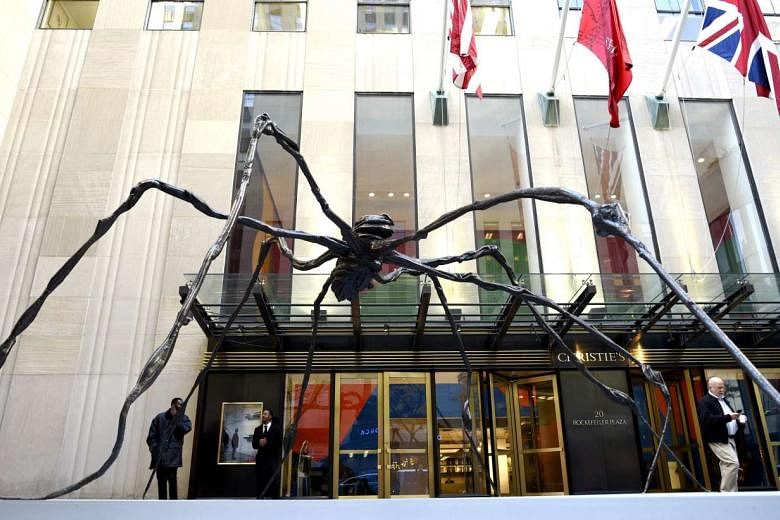WASHINGTON (AFP) - For Louise Bourgeois, hell is the absence of others. A new Washington show featuring her early works offers an intimate portrait of this "fragile goddess" and her deeply personal take on isolation, sex and motherhood.
The National Gallery of Art in Washington chose to present just four sculptures by the late French-born artist known for her giant metal spiders that have spun their webs across the globe.
Instead, the museum focused on recently acquired, rarely shown works, including pen drawings (1947-1950) reminiscent of the Aubusson region of central France, home to Bourgeois' mother and known for its tapestries.
The show also features engravings and one of only three hand-coloured copies of her large-scale book The Puritan (1990).
Bourgeois only gained recognition late in life but the pieces shown here, most of them created around the time of World War II, already took up the central themes that made her famous in old age.
She was often labelled a member of the surrealist movement, but the artist bristled at the notion, identifying herself instead with the existentialists led by Jean-Paul Sartre, a contemporary of hers.
Opening on Sunday and running for six months ending May 15, the show's title, Louise Bourgeois: No Exit, is a direct allusion to Sartre's work.
His 1944 play No Exit (Huis Clos) offers a vision of a claustrophobic afterlife in which three souls are forced to share a single room, leading one to famously proclaim: "Hell is other people."
In a confined, dead end space in the Washington show, three totemic sculptures allude to Sartre's tormented souls.
"Exploring the existential side of Louise Bourgeois is really what inspired the exhibition," curator of modern prints and drawings Judith Brodie said.
"I think it's borne very much out of a wartime sensibility," she explained, noting that Bourgeois emigrated to the United States on the eve of World War II. "That sense of isolation, miscommunication, people trying to communicate, the struggle of trying to find a meaningful existence in a world that is basically indifferent."
But existentialism, as pioneered by Sartre in the post-war period, also emphasises free will and the inspiring possibilities it offers.
"We create our own lives, we choose. Nobody chooses for us," said senior curator Andrew Robison.
"So (when) you go through Louise Bourgeois, that's very important to keep in mind. Because you're a little bit inclined towards the left (negative) side, but you want to keep in mind the right (positive) side."
"Expose a contradiction, that is all you need," once said Bourgeois, who died in 2010 in New York at the age of 98.
Engravings from her limited-edition 1947 book, He Disappeared into Complete Silence, hint at how hard it can be to communicate - such as one filled with ladders hung from the ceiling, leading nowhere.
Across the 21 works exhibited here, the artist drew from her own experience to turn the intimate into the universal, exploring themes around the body, sexuality and architecture.
"For Louise Bourgeois, life is art and art is life," Ms Brodie said.
Mr Robison said sexual themes are "very clear" in some pieces, such as the small marble sculpture Germinal (1967), which subverts traditional phallic depictions with its delicate fingers protruding from a half-circle.
As with her famous spiders, a maternal presence is everywhere in Bourgeois's work, both evocative and ominous.
"There is a sense that the mother is such an important figure but the influence of the mother never relaxes," said Ms Brodie.
A mother of three, Bourgeois acknowledged she projected into her work the traumas of a childhood marked by a philandering father and an idolised, protective mother.
In M is for Mother (1998), the letter is traced multiple times in pen and red ink.
"In the drawing, the M is made from many strands of lines, and they look very much like hair, and they also could be thought of as some sort of web," said Ms Brodie, who sees a clear parallel with the artist's spider sculptures.
Museum-goers can make the comparison for themselves by stepping out into the National Gallery's gardens, where a Bourgeois spider reigns supreme.

